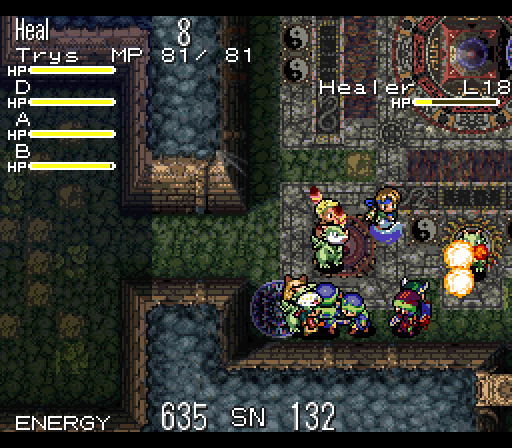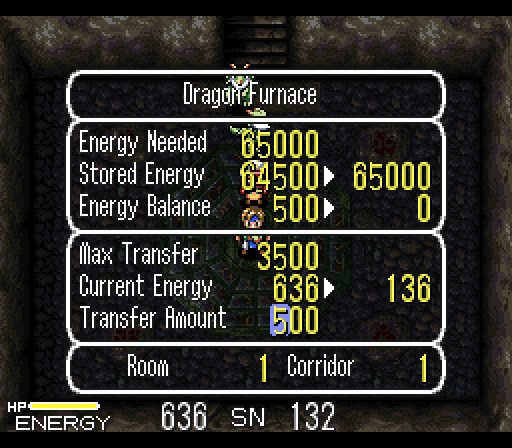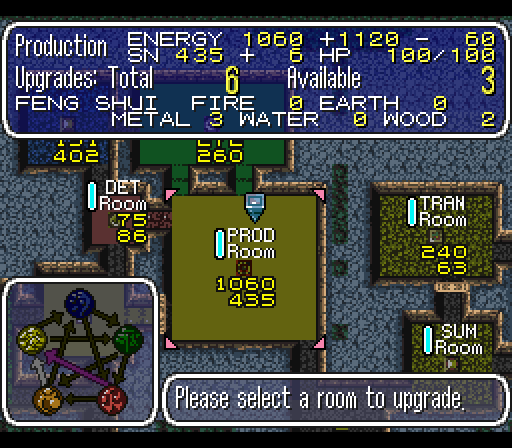2019-05-05: Chaos Seed: The Feng Shui Dungeon Keeper ARPG
Chaos Seed: Fuusui Kairoki (localized by fan translators as Chaos Seed: Feng Shui Chronicles) is a rare thing in the SNES/SFC library: a completely unique concept that defies comparison to any other game in the library, or maybe in the libraries of its entire generation of platforms. The closest thing I can call it, albeit as a little bit of a tongue-in-cheek joke, is a Feng Shui based Dungeon Keeper in an engine not unlike Neugier or, if you don't follow the weird imports I've played, Illusion of Gaia.
The core gist of it is this: you're an earth mage (A Dousen, in the translation) on a mission to heal and tend the earth by injecting spiritual energy into ley lines that encompass the planet. To do this you have to build an enchanted cave that consists of energy gathering rooms. To support and upgrade those rooms, you need summons, production/upgrade materials (Sentan), methods of defending the cave from intruders, and the like. It's very Dungeon Keeper but with the player taking the role of a misunderstood good guy instead of a very properly understood villain.
The game takes place across several scenarios. At the start of each scenario your Dousen is returned to level 1, your cave is reset, and a different arc of the plot unfolds. You're told how much energy you need to inject into the ley line (or Dragon Vein), and are sent off to accomplish the task. Through each scenario scripted events occur to further the plot, you're given access to side-areas to explore to gather resources and uncover new characters, items, creatures, and the like... and eventually you overcome the invaders in your cave and meet your goal to close out the scenario and see the ending play out.
Each scenario then consists of an arbitrary number of turns. Each turn lasts for anywhere from 20 to 45 time units (which seem to be around 5 seconds each) and you are allowed to roam your cave freely during this time, building rooms, repelling invaders with action RPG combat, harvesting energy and sentan from production and refinery rooms, and visiting the Dragon Furnace at the cave's core to deposit the energy and possibly visit side-dungeons underneath the cave. Between turns you can upgrade rooms with sentan, inspect the state of your cave, and order your summoned monsters to maintain and guard the cave. Every scenario but one has an infinite number of turns, the scenario only ending when you finish the goal at hand.
This is what creates a unique game cycle in Chaos Seed: each turn you have about 1-2minutes to make the changes you want in your cave, repel the invaders, harvest energy, and get to the Furnace to deliver it. Many times you will not be able to do everything you want in one turn, so you have to prioritize, plan, and make sacrifices. Then of course, there's building the cave...
Scenarios start with part of a cave built; at least a room. You expand the cave by walking up to a wall and pulling on it. Once you do so, the build interface opens and from here you can expand your cave through the pulled wall with either a corridor or another room. There's eight room types and you need most of them to make a successful cave:
- Production Rooms which give energy
- Refineries which give sentan, which is needed to summon and upgrade
- Summoning Rooms to summon and heal monsters
- Transfer Rooms to warp across the cave
- Detection Rooms to see incoming invaders and the portals they use
- Attack Rooms open fire on invaders that enter them, and allow the purchase of traps
- Excavation Rooms produce random items that can be used or equipped
- Storage Rooms allow you to store items for retrieval later, and also increase how much energy you can dump into the Furnace
You can, technically, finish the game building nothing but Production Rooms, but it would take utterly forever. Instead, you build Production Rooms, upgrade them to produce more energy with sentan from Refineries, traffic that sentan to the Production Rooms with monsters from Summon Rooms, and better defend your cave with Transfer and Detection Rooms. The other three room types are less necessary but still useful.
The productivity of a room is determined by several factors including its size, and how many energy, sentan, or item nodes are inside of it. These nodes appear randomly in each map, and are impactful enough that it's worth going a little out of your way to make sure your rooms include them. Additionally, while there's eight room types, a given room can only be one of six of them; this is determined by the room's element, which is determined by its position. This will frequently ruin your carefully laid plans as you create a perfect room encircling half a dozen energy nodes, in a perfect place, and find that specific room cannot be a Production Room due to its element. Alas.
As if that's not enough, each room's element also results in elemental energy flowing to adjacent rooms. If a room receives the right combination of elemental energy points, it gets new upgrade paths. In this way, you can dump earth energy into a Production Room and it will suddenly gain the ability to also generate sentan, or you can create a complicated cluster of rooms to get exactly the right elemental affinities needed to buy an upgrade that makes every room in the dungeon better! It's a super complex system. I largely ignored it in my playthru because it was just too much; so I was happily surprised when I accidentally scored a bonus upgrade with it.
So perfect cave design involves creating a cave you can quickly navigate to defend it, defends itself with Summons and Attack Rooms, transfers energy and sentan across itself to keep rooms powered and upgrading smoothly, doesn't hit any element based land mines like the one perfect place for a Refinery not being able to build a Refinery, and then has elemental energy proliferation such that you get the best upgrades. It's literally impossible to build an ideal cave, and very difficult to predict and plan how a cave should go.
As for the plot: the scenarios follow one major plot thread that is the life of the protagonist Dousen. Through the course of that plot, a whole lot of time muckery occurs in that a dragon arrives and throws the Dousen across spacetime in what seems to be a lust for revenge. Over the next several scenarios, you see multiple different parallel universe takes of the same world, and bit by bit unwind what exactly happened to cause the initial events with the dragon. Finally you go back in time to the moment you're thrown across spacetime and prevent it to set the timeline right. From there, the plot focuses on the Dousen and his attempt to return to a normal life in his own timeline and universe, eventually ending in a cute romance and wrap-up.
I'm glossing over a lot, including as I described it... "two concentric stable time loops". The plot is a mindfrag, and amazingly executed. I don't want to spoil it.
If I had the ding the game for anything, it'd be that it wears out its welcome just a bit. You can approach the game in one of two ways: you can either improve your cave through an entire scenario, sprawling it out larger and larger and increasing how much you have to defend... or you can get a stable cave and stop improving, and just wait out the energy needed to finish the scenario. I found the latter option to be more viable in most scenarios, and that results in a lot of doing the same cycle of repel intruders, harvest energy, donate energy at furnace over and over again.
The game tries to keep itself fresh by mixing up goals from scenario to scenario. One scenario just wants a bunch of energy, another forces you to complete a dungeon in chunks divided by energy contribution quotas, another gives you a turn limit before a powerful enemy attacks. At the end though 90% of the game is the energy cycle, for better or worse. With multiple ways to tackle cave building, you can challenge yourself to take a different approach each scenario to try to keep it from getting stale, but in a game where a normal completion takes 35 hours, it's a hard sell to keep it fresh the whole way through.
35 hours, by the way, is just to get to the end of the main plot thread in scenario 7. On top of that, there's two scenarios of "side story", and a 10th scenario that is unlocked by completing the entire game: every ending of every scenario. Oh yeah, most of the scenarios have multiple endings decided by your actions through the scenario; some of them are bad ends that don't allow continuation of the game. Some scenarios even force you to get the bad end once, then guide you more clearly to the good end on a return trip. Looking around for 100% completions, it looks like that can be expected to take 60-70 hours. This game is long!
All in all, it's one of my favorite games on the system. Not one I'd fire back up just because, but it's unique, it's cute, its plot is endearing and well executed, its mechanics are fresh and different and only just start to get stale by the end. I would have been happier if it took 25 hours instead of 35, but I don't know how much of that was me and my approach.
One of my new faves for certain.
tags: chaos_seed, game_writeup



